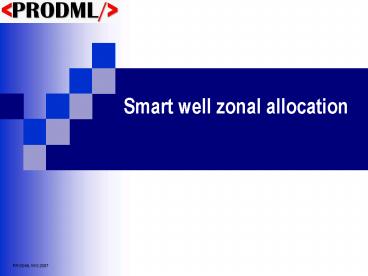Smart well zonal allocation - PowerPoint PPT Presentation
1 / 29
Title:
Smart well zonal allocation
Description:
By Schlumberger is the orchestrator of automated workflows and data consolidation ... Asset Modeller (IAM) by Schlumberger is the optimizer and forecaster ... – PowerPoint PPT presentation
Number of Views:98
Avg rating:3.0/5.0
Title: Smart well zonal allocation
1
Smart well zonal allocation
2
The Problem
- To run smart wells at its optimum level it must
be possible to determine the zonal reservoir
pressure at any time and compare those with the
theoretical expected pressure calculated from
your well and network models. A comparison of
the theoretical value with the actual calculated
value is a key performance indicator if the
well/reservoir behaved as expected. If not the
system needs to be recalibrated.
3
The Team
- IP21 by Aspentech is the data historian
- EnergyComponents by TietoEnator is the
production database - Prosper by Petroleum Experts is a Well modelling
application - DECIDE! By Schlumberger is the orchestrator of
automated workflows and data consolidation - Avocet Production Surveillance by Schlumberger is
the visualization tool - Avocet - Integrated Asset Modeller (IAM) by
Schlumberger is the optimizer and forecaster
4
The Workflow
- The integrated asset model will consume
historical production and injection data to
calculate production and injections targets
(forecast). - Those targets will be used to in the consolidator
to compare the targets to the actually achieved
values - The measured temperature and pressure at each
zone (downhole sensor data available via data
historian) will be used to calculate zonal and
total rates and to calculate the reservoir
pressure per zone - The reservoir pressure and rates can be used in
an advanced process controller to calculate the
optimum choke setting on how to operate the well
within the targets and the constraints.
5
The interactions
9
13
PETEX Prosper/GAP
APS
8
7a
7b
4
Decide!
10
1
14b
IAM
12a
12b
14a
3b
3a
2b
6b
2a
6a
5b
11b
Advanced Process Control
5a
11a
11
TE EnergyComponents
Aspentech IP21
6
Setup the IAM model
7
Set PI Targets
8
Create new PRODML connection
9
Point to TietoEnators web service
10
Define the well(s) to query for
11
Define the parameter(s) to query for
12
View resulting query and response
13
View data that is to be acquired
14
and acquire it to DECIDE!
15
Create new PRODML connection
16
Point to Aspentech web service
17
Select the well(s) to query for
18
Define the parameter(s) to query for
19
View query template and results
20
View query template and results
21
Optionally data cleansing rules to the data
22
View resulting data that will be acquired
23
Finish initial data acquisition
24
This connection can than be automated
25
in a DECIDE! workflow
26
Advanced Process Control
New IAM data (5 Increase)
Sample
180
185
190
195
200
290
295
300
305
New velocity limit
27
The web viewer can visualize the acquired data
28
and the calculated pressures
29
Calculated KPI for monitoring the performance
30
Rerun optimization if performance declines































